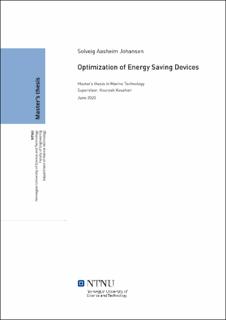| dc.contributor.advisor | Koushan, Kourosh | |
| dc.contributor.author | Johansen, Solveig Aasheim | |
| dc.date.accessioned | 2021-09-21T16:29:39Z | |
| dc.date.available | 2021-09-21T16:29:39Z | |
| dc.date.issued | 2020 | |
| dc.identifier | no.ntnu:inspera:54166542:52361470 | |
| dc.identifier.uri | https://hdl.handle.net/11250/2780120 | |
| dc.description.abstract | Som følgje av auka fokus på klima og høgare drivstoffprisar, har det dei siste tiåra vore ein veksande etterspurnad etter ny teknologi for å betre energieffektiviteten til skip. Ein av dei enklaste og mest effektive metodane for å få ned drivstofforbruket for eit skip, er ved å optimalisere propulsjonssystemet. Det finns ei rekkje tiltak som senkar drivstofforbruket, og eit av tiltaka ein kan nytte er å implementere energisparande einingar som er designa for å optimalisere propulsjonseffektiviteten. Ein type energisparingseining er pre-swirl stators, frå no av referert til som PSS. Ein PSS består av tre til fem finnar som er plassert framfor propellen, og er designa til å manipulere strøyminga inn i propellen. Ved å få ei meir homogen strøyming inn i propellen vil verknadsgraden til propellen gå opp, og ein vil minske energiforbruket til skipet.
Målet med denne masteroppgåva er å optimalisere ein PSS som blir brukt på eit kjemikalietankskip. Gjennom eit optimaliseringsstudie vil ulike designparametrar som finne-radius, vinkelposisjon og pitch-vinkel bli variert slik at det optimale designet kan bli identifisert. Dei hydrodynamiske kreftene som verkar på systemet vil bli funne gjennom numeriske berekningar i Star-CCM+. Ved å implementere ulike fysiske modellar i den virtuelle slepetanken, vil tankskipet bli simulert både med og utan fri overflate. Simuleringa som er utført med fri overflate er gjort som ein del av valideringsprosessen for det numeriske oppsettet. Optimaliseringsprosessen for finnane er utført utan fri overflate for å spare køyretid i kalkuleringane.
16 ulike designkonfigurasjonar er undersøkt for å finne det optimale PSS-designet. Frå resultata i simuleringane ser ein at alle designkonfigurasjonane gir auka propellverknadsgrad samanlikna med propellen utan PSS. Det optimale designet gir ein auka propellverknadsgrad på 8.5%, som er 3.85% høgare enn for det originale designet av PSS. Den relative motstanden er også auka med 4.72%, som følge av auka thrust og konstant skipshastigheit og propulsjonshastigheit.
Frå simuleringane av det optimale PSS-designet kan ein sjå korleis strøyminga blir påverka av finnane. Frå resultata kan ein sjå at virvelen som oppstår på grunn av avløysing framfor propellen blir løyst opp av finnane. Det er også tydeleg at krafta til virvelen bak propellnavet minkar. Trykkoeffisienten på propellblada endrar seg også, så kavitasjonsdomena på propellblada blir undersøkt. | |
| dc.description.abstract | Due to environmental awareness and an increase in fuel prices, there has been an increasing demand for new technology to improve ship's energy efficiency to reduce fuel consumption. One of the simplest and most effective methods to improve fuel efficiency is to improve propulsion performance. This could be done in several ways, but one measure is to implement energy saving devices that are designed to optimize the propeller efficiency. One type of energy saving devices that improve propeller efficiency is pre-swirl stators. The PSS usually consists of 3-5 fins, designed to manipulate the inflow to the propeller to make it more homogeneous, and thus increase propeller efficiency.
The objective of this thesis is to optimize a pre-swirl stator used on a chemical tanker. By improving the propeller efficiency, the energy consumption of the ship will decrease. Through an optimization study on design parameters such as fin radius, angular position of fins, and the pitch angle of the fins, the best PSS design configuration will be found. The hydrodynamic performance for the different configurations is found through numerical calculations in Star-CCM+. By systematically varying the design parameters one by one and investigating how the hydrodynamic performance is influenced, the optimal design is found for the pre-swirl stator.
All simulations conducted for this study is performed using Star-CCM+. By implementation of different physical models, the chemical tanker is simulated with and without the presence of free surface. The free surface simulation is performed as a part of the validation study of the numerical set-up. The optimization process is performed without free-surface to save computational time. The numerical set-up is validated through a comparison of the resistance coefficient and the nominal wake of another numerical study conducted on the same ship. Results from these comparisons showed good agreements between the two studies.
16 different pre-swirl design configurations were investigated in the optimization process. By systematic variation of the design parameters, the various configurations were investigated through numerical computations. Through a study of the increased propeller efficiency, increased ship resistance and the wake field, the optimal design configuration is found. From the results it is found that all PSS configurations give some increase in propeller efficiency. The optimal solution provides a increased propeller efficiency of 8.51% relative to the propeller without PSS, and 3.85% more than the initial PSS configuration. This configuration increases the average relative resistance with 4.72% compared to the ship without PSS. Since the study was carried out with a fixed rotational velocity of the propeller, the resistance increase when the thrust is increased.
From the simulation of the optimal configuration, the influence of the PSS is visualized. From these figures, it is visible how the PSS alters the flow around the aft ship. The streamlines show that the PSS cancels out the vortex from flow separation in front of the propeller, and the pressure coefficient is plotted to evaluate the cavitation domains. | |
| dc.language | | |
| dc.publisher | NTNU | |
| dc.title | Optimization of Energy Saving Devices | |
| dc.type | Master thesis | |
